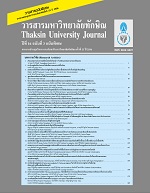การตรวจหาการปนเปื้อน Vibrio parahaemolyticus ในอาหารทะเลสดที่จำหน่ายในกรุงเทพและการศึกษาการต้านทานความร้อน
Main Article Content
Abstract
การศึกษานี้มีจุดประสงค์เพื่อประเมินการปนเปื้อนของ Vibrio parahaemolyticus ในอาหารทะเลสด 50 ตัวอย่าง (กุ้ง ปลา ปลาหมึก หอยนางรม และหอยแมลงภู่) ที่จำหน่ายในตลาดในกรุงเทพ ปริมาณเชื้อนี้ที่พบ (ร้อยละ 80 ของตัวอย่างทั้งหมด) อยู่ในช่วง 24 ถึงมากกว่า 11,000 MPN ต่อกรัม จึงได้แยกเชื้อและจำแนกชนิดโดยอาศัยลักษณะ ทางสัณฐานวิทยาและชีวเคมี การศึกษาผลของการใช้ความร้อนในการทำลาย V. parahaemolyticus 3 ไอโซเลตคือไอโซ เลต SH1 ที่แยกได้จากกุ้งสด ไอโซเลต GS1 ที่แยกได้จากปลาสดและไอโซเลต MS2 ที่แยกได้จากปลาหมึกสด โดยหา ค่า Decimal reduction time (D value) ที่อุณหภูมิ 55, 75 และ 95 องศาเซลเซียสในกุ้ง ปลาและปลาหมึกตามลำดับพบว่า ค่า D ในอาหารทะเลแต่ละชนิดลดลงตามอุณหภูมิของการให้ความร้อนที่เพิ่มขึ้น โดยค่า D55°C, D75°C และ D95°C ของเชื้อ แต่ละไอโซเลตเท่ากับ 125.02–16.48 วินาทีในกุ้ง 111.76–16.52 วินาทีในปลา และ107.32-16.13 วินาทีในปลาหมึก
Detection of the Contamination of Vibrio parahaemolyticus from Raw Seafood Sold in Some Bangkok Freshfood Market and Thermal Inactivation Study
Suree Nanasombat1*, Nawarat Potiraj2, Pratoom Sanma2, Watthanon Hapermpool2 and Sittichok Sirisornchai2
This study aimed at evaluating the contamination of Vibrio parahaemolyticus in 50 raw seafood samples (shrimps, fish, squids, oysters and mussels) sold in some markets in Bangkok. The number of V. parahaemolyticus found in these seafoods (80% of total samples) were in the range of 24 to more than 11,000 MPN/g. They were isolated and identified by morphological and biochemical methods. Then, thermal inactivation of three V. parahaemolyticus isolates ( isolate SH1 isolated from shrimp, isolate GS1 isolated from fish and isolate MS2 isolated from squid) was studied by determining the decimal reduction times (D value) at 55๐C, 75๐C, and 95๐C of each isolates in raw shrimp, fish and squid, respectively. D value of this bacterium in each type of seafoods decreased as heating temperature increased. The D55°C, D75°C and D95°C of each isolate were 125.02–16.48 sec (in shrimp), 111.76– 16.52 sec (in fish), and 107.32-16.13 sec (in squid).


